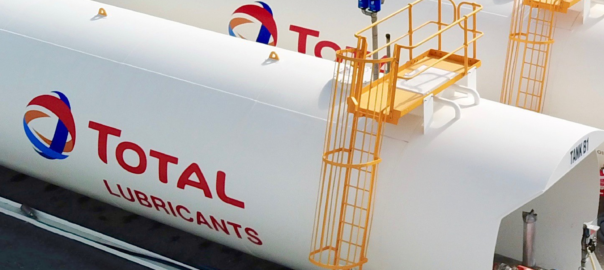07/01/2020 News
When handling bulk, there's no room for doubt

Total Oil Australia explains why lubrication assessment and site audits aren’t as straightforward as they seem, and often require professional insight.
When it comes to safety and compliance in the area of lubricant storage and handling, Total Oil Australia is a leading industry expert that goes further than meeting manufacturer requirements – the company exceeds the highest level of industry specifications.
Total is a market-leading lubricant manufacturer, with a strong international presence in more than 130 countries.
Australian Mining speaks with Total Oil Australia’s mining operations and engineering specialist, George Walker, about the best practices companies should adhere to when it comes to lubricant storage and handling.
Why is it important for Total Oil Australia to carry out audits on bulk storage facilities?
Total has several tools to perform lubrication assessments and site audits. Upon winning a contract, Total conducts a baseline audit as part of the client’s transition plan to our lubricant and grease products. The audit incorporates a step process to review all storage assets, pumps and pipework, ISO4406 filtration, maintenance processes and documentation (schematics).
Through the audit, both positive and negative aspects of the hydrocarbon management (HCM) storage practices are identified. Safety and compliance to AS1940-2017 issues are also highlighted, and improvements are proposed along with client contractual mandates. Improving storage and handling helps to reduce health, safety and environment (HSE) costs associated with storage and handling of lubricant products.
The main objective of the assessment is to determine the baseline situation of the HCM storage and handling activities, including safety issues that require immediate rectification. Total is also able to offer the range of value-add opportunities that can be leveraged from Total’s global services for the use of lubricants and greases.
In addition, the issue of contamination is often overlooked when considering the reason(s) for premature failures or why lubricant life diminishes. Ensuring that cleanliness of the oil is maintained throughout – from storage to usage – must be a key focus of companies.
What are the common issues of non-compliance identified during a site audit?
There are a number of basic issues we commonly identify, including safety signs that are faded and needed replacement; a failure to check and confirm whether high level fill alarms are functioning properly; timeliness of bulk tank inspections; and stored energy, particularly in bulk grease dispensing lines, which is a safety hazard.
The other main cause of non-compliance occurs when the client is unaware of updates to the AS1940-2017 standard and consequently believes they are still compliant.
Are safety compliance issues identified during a site audit?
Safety compliance is Total’s number one priority. The most common factor is on-demand systems within the mining industry, which creates stored energy injury scenarios.
One of Total’s solutions was to create a grease plug and play system to hold two or three grease intermediate bulk vessels. The system provides an option for high or low-pressure grease pumps to be fitted.
For safety compliance reasons, all units are fitted with pressure gauges and vent valves to enable the safe release of any “stored energy” in the grease system, thus eliminating any potential of a grease injection incident occurring.
Raising these issues to clients can be challenging as they may be unaware of the risks involved, and at times may not agree that the risk(s) needs to be addressed. The emphasis is then to align responsibility and incorporate preventive actions between Total and the client to ensure identified risks are appropriately dealt with. Total’s audit report for our clients includes statutory, safety and operational requirements, which exceeds best industry practices.
How does Total ensure that facilities are up to standard?
While Total does have its own stringent standards, during both site audits in Australia and audit reports to the client, our personnel refers to the Australian Standards AS1940-2017 to ascertain compliance according to country legislative requirements.
The AS1940-2017 sets out the requirements and recommendations for the storage and handling of flammable and combustible liquids. Its objective is to promote safety and prevent damage to the property and environment, where flammable or combustible liquids are handled and stored.
Total has developed what we call the “The 50 Point Assessment Tool,” which comprises specific items relating to safety, general inspections, bulk grease storage, as well as filling and dispensing.
During site audits, Total uses this tool to assess the areas associated with the above categories and will highlight where the site has been non-compliant, according to AS1940-2017, or where safety issues are prevalent. Any safety concern identified during the audit will trigger a safety alert bulletin, which prompts a follow up until resolution is reached.
How is Total’s service unique in the industry?
The unique nature of Total’s site audit and inspection services lies in its ‘safety first’ culture, on top of ensuring compliance in bulk storage facilities. Our inspections cover all requirements within the AS1940-2017.
Total brings expertise from working with global operators with an emphasis on being client focussed. Total further aims to provide additional value-add from its range of product and global service offerings with a large focus on hydrocarbon safety and compliance, education and training.
Moreover, Total’s 12 global Golden Rules on safety are also applied to operational and maintenance aspects. Total’s site audits are commercial-in-confidence and aims to deliver ‘peace-of-mind’ to its clients.
By using Total’s services, the mining sector can be assured of “additional safeguards”, with Total conducting a gap analysis to ensure that bulk facilities meet or exceed statutory compliance.
This article also appears in the December 2019 edition of Australian Mining.

